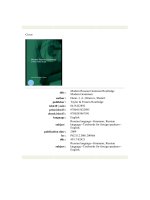spanish demystified a self-teaching guide
Bạn đang xem bản rút gọn của tài liệu. Xem và tải ngay bản đầy đủ của tài liệu tại đây (13.07 MB, 496 trang )
spanish
DeMYSTiFieD
Accounting Demystifi ed
Advanced Calculus Demystifi ed
Advanced Physics Demystifi ed
Advanced Statistics Demystifi ed
Algebra Demystifi ed
Alternative Energy Demystifi ed
Anatomy Demystifi ed
asp.net 2.0 Demystifi ed
Astronomy Demystifi ed
Audio Demystifi ed
Biology Demystifi ed
Biotechnology Demystifi ed
Business Calculus Demystifi ed
Business Math Demystifi ed
Business Statistics Demystifi ed
C++ Demystifi ed
Calculus Demystifi ed
Chemistry Demystifi ed
Circuit Analysis Demystifi ed
College Algebra Demystifi ed
Corporate Finance Demystifi ed
Databases Demystifi ed
Data Structures Demystifi ed
Differential Equations Demystifi ed
Digital Electronics Demystifi ed
Earth Science Demystifi ed
Electricity Demystifi ed
Electronics Demystifi ed
Engineering Statistics Demystifi ed
Environmental Science Demystifi ed
Everyday Math Demystifi ed
Fertility Demystifi ed
Financial Planning Demystifi ed
Forensics Demystifi ed
French Demystifi ed
Genetics Demystifi ed
Geometry Demystifi ed
German Demystifi ed
Home Networking Demystifi ed
Investing Demystifi ed
Italian Demystifi ed
Java Demystifi ed
JavaScript Demystifi ed
Lean Six Sigma Demystifi ed
Linear Algebra Demystifi ed
Macroeconomics Demystifi ed
Management Accounting Demystifi ed
Math Proofs Demystifi ed
Math Word Problems Demystifi ed
MATLAB ® Demystifi ed
Medical Billing and Coding Demystifi ed
Medical Terminology Demystifi ed
Meteorology Demystifi ed
Microbiology Demystifi ed
Microeconomics Demystifi ed
Nanotechnology Demystifi ed
Nurse Management Demystifi ed
OOP Demystifi ed
Options Demystifi ed
Organic Chemistry Demystifi ed
Personal Computing Demystifi ed
Pharmacology Demystifi ed
Physics Demystifi ed
Physiology Demystifi ed
Pre-Algebra Demystifi ed
Precalculus Demystifi ed
Probability Demystifi ed
Project Management Demystifi ed
Psychology Demystifi ed
Quality Management Demystifi ed
Quantum Mechanics Demystifi ed
Real Estate Math Demystifi ed
Relativity Demystifi ed
Robotics Demystifi ed
Sales Management Demystifi ed
Signals and Systems Demystifi ed
Six Sigma Demystifi ed
sql Demystifi ed
Statics and Dynamics Demystifi ed
Statistics Demystifi ed
Technical Analysis Demystifi ed
Technical Math Demystifi ed
Trigonometry Demystifi ed
uml Demystifi ed
Visual Basic 2005 Demystifi ed
Visual C# 2005 Demystifi ed
xml Demystifi ed
Demystifi ed Series
spanish
DeMYSTiFieD
Jenny Petrow
New York Chicago San Francisco Lisbon London Madrid Mexico City
Milan New Delhi San Juan Seoul Singapore Sydney Toronto
Copyright © 2007 by The McGraw-Hill Companies, Inc. All rights reserved. Manufactured in the United States of America. Except
as permitted under the United States Copyright Act of 1976, no part of this publication may be reproduced or distributed in any
form or by any means, or stored in a database or retrieval system, without the prior written permission of the publisher.
0-07-159655-0
The material in this eBook also appears in the print version of this title: 0-07-147658-X.
All trademarks are trademarks of their respective owners. Rather than put a trademark symbol after every occurrence of a
trademarked name, we use names in an editorial fashion only, and to the benefit of the trademark owner, with no intention of
infringement of the trademark. Where such designations appear in this book, they have been printed with initial caps.
McGraw-Hill eBooks are available at special quantity discounts to use as premiums and sales promotions, or for use in corporate
training programs. For more information, please contact George Hoare, Special Sales, at or (212)
904-4069.
TERMS OF USE
This is a copyrighted work and The McGraw-Hill Companies, Inc. (“McGraw-Hill”) and its licensors reserve all rights in and to
the work. Use of this work is subject to these terms. Except as permitted under the Copyright Act of 1976 and the right to store and
retrieve one copy of the work, you may not decompile, disassemble, reverse engineer, reproduce, modify, create derivative works
based upon, transmit, distribute, disseminate, sell, publish or sublicense the work or any part of it without McGraw-Hill’s prior
consent. You may use the work for your own noncommercial and personal use; any other use of the work is strictly prohibited. Your
right to use the work may be terminated if you fail to comply with these terms.
THE WORK IS PROVIDED “AS IS.” McGRAW-HILL AND ITS LICENSORS MAKE NO GUARANTEES OR WARRANTIES
AS TO THE ACCURACY, ADEQUACY OR COMPLETENESS OF OR RESULTS TO BE OBTAINED FROM USING THE
WORK, INCLUDING ANY INFORMATION THAT CAN BE ACCESSED THROUGH THE WORK VIA HYPERLINK OR
OTHERWISE, AND EXPRESSLY DISCLAIM ANY WARRANTY, EXPRESS OR IMPLIED, INCLUDING BUT NOT
LIMITED TO IMPLIED WARRANTIES OF MERCHANTABILITY OR FITNESS FOR A PARTICULAR PURPOSE.
McGraw-Hill and its licensors do not warrant or guarantee that the functions contained in the work will meet your requirements or
that its operation will be uninterrupted or error free. Neither McGraw-Hill nor its licensors shall be liable to you or anyone else for
any inaccuracy, error or omission, regardless of cause, in the work or for any damages resulting therefrom. McGraw-Hill has no
responsibility for the content of any information accessed through the work. Under no circumstances shall McGraw-Hill and/or its
licensors be liable for any indirect, incidental, special, punitive, consequential or similar damages that result from the use of or
inability to use the work, even if any of them has been advised of the possibility of such damages. This limitation of liability shall
apply to any claim or cause whatsoever whether such claim or cause arises in contract, tort or otherwise.
DOI: 10.1036/007147658X
We hope you enjoy this
McGraw-Hill eBook! If
you’d like more information about this book,
its author, or related books and websites,
please click here.
Professional
Want to learn more?
v
CONTENTS
Acknowledgments xi
Introduction xiii
PART ONE LEARNING THE BASICS
CHAPTER 1 Introduction to Spanish 3
The Spanish You Already Know 3
The Spanish Alphabet and Pronunciation 6
Regional Variations in Pronunciation 16
QUIZ 17
CHAPTER 2 Talking About People and Things 19
Nouns and Gender 20
Defi nite and Indefi nite Articles 24
Use of Indefi nite Articles 26
Use of Defi nite Articles 27
The Plural Form of Nouns 30
Diminutives 32
Pronunciation: Word Stress 33
QUIZ 35
CHAPTER 3 Talking About Actions and Possession 37
Subject Pronouns 38
An Introduction to Verbs 39
The Verb Ser 39
Countries and Nationalities 41
Making a Sentence Negative 42
For more information about this title, click here
vi
Contents
Asking Yes/No Questions 42
Verb Stems and Endings 46
Verbs Ending in -ar: Present Tense 47
Uses of the Present Tense 48
Possessive Adjectives 50
QUIZ 54
CHAPTER 4 Describing People and Things 57
Adjectives 57
The Question Words ¿Quién?, ¿Qué?, ¿Cuál?, and
¿Por qué? 65
Verbs Ending in -er: Present Tense 70
Verbs Ending in -ir: Present Tense 72
QUIZ 74
CHAPTER 5 Talking About Location and Time 77
The Question Words ¿Dónde?, ¿Cómo?,
¿Cuándo?, and ¿Cuánto? 78
The Verb Estar 80
Prepositions of Place and Location 82
The Verb Ir 86
Cardinal Numbers 88
Ordinal Numbers 91
Talking About Time 91
Days, Months, and Seasons 95
Hellos and Good-byes 97
QUIZ 98
PART ONE TEST 101
PART TWO EXPRESSING YOURSELF IN THE PRESENT
CHAPTER 6 Using Common Irregular Verbs 109
The Verb Form Hay 110
Conjunctions 111
The Verb Hacer 113
Talking About the Weather 116
The Verbs Tener and Venir 118
Uses of Tener 119
QUIZ 124
CHAPTER 7 Expressing Likes and Dislikes 127
Stem-Changing Verbs in the Present Tense 127
The Personal A 132
Demonstrative Adjectives and Pronouns 133
The Verb Gustar 137
Other Verbs That Behave like Gustar 142
QUIZ 144
CHAPTER 8 Expressing Actions in Progress 147
The Present Progressive with Estar 148
Forming Present Participles 149
The Present Progressive with Ir and Seguir 152
Indefi nite Adjectives 153
Indefi nite Pronouns 154
Double Negatives 156
Possessive Pronouns 158
The Verbs Saber and Conocer 161
QUIZ 164
CHAPTER 9 Using Refl exive Verbs 167
The Future with Ir ϩ a 167
More Irregular Verbs in the Present Tense 170
Refl exive Verbs 173
Refl exive Verbs with Multiple Meanings 178
Reciprocal Verbs 183
QUIZ 183
CHAPTER 10 Making Comparisons 185
Making Comparisons 185
Superlative Adjectives 192
Contents
vii
viii
Contents
Comparatives and Superlatives with Verbs 194
The Exclamation ¡Qué! 196
Ser or Estar? 198
QUIZ 202
PART TWO TEST 205
PART THREE MOVING BEYOND THE PRESENT
CHAPTER 11 Making Commands 213
Making Commands with the Imperative Mood 214
Formal Commands 214
Familiar Commands 217
First-Person Plural Commands 220
Commands with Refl exive Verbs 222
Making Commands More Polite 224
The Irregular Verbs Dar and Decir 226
Direct Object Pronouns 227
QUIZ 232
CHAPTER 12 Using the Future and the Conditional 235
The Future Tense 236
Uses of the Future Tense 237
Indirect Object Pronouns 240
The Pronoun Lo 246
The Conditional 247
Augmentative Forms of Nouns 251
QUIZ 252
CHAPTER 13 Talking About the Past with the Preterit 255
The Preterit Tense 256
Double Object Pronouns 261
Using Adjectives as Nouns 264
The Preterit of Irregular Verbs 266
QUIZ 271
CHAPTER 14 Describing Actions in the Past with
the Imperfect 273
The Imperfect Tense 274
The Imperfect Progressive Tense 279
Using Ir a, Volver a, and Acabar de 280
Adverb Formation 281
Expressions of Time with Hacer 283
QUIZ 290
CHAPTER 15 Using the Preterit and the Imperfect 293
Preterit versus Imperfect 293
Verbs That Change Meaning in the Preterit
and the Imperfect 298
Uses of the Preterit and the Imperfect 301
Relative Pronouns and Adjectives 303
QUIZ 312
PART THREE TEST 315
PART FOUR MASTERING THE SUBJUNCTIVE
CHAPTER 16 Introduction to the Subjunctive 323
The Subjunctive 324
Present Subjunctive of Regular Verbs 325
Present Subjunctive of Stem-Changing Verbs 326
Present Subjunctive of Irregular Verbs 328
Spelling Changes in the Present Subjunctive 329
Using the Subjunctive to Express Doubt
and Uncertainty 330
QUIZ 337
CHAPTER 17 More About the Subjunctive 339
Using the Subjunctive to Express Wishes, Wants,
and Desire 339
Impersonal Expressions and the Subjunctive 342
Questioning Existence with the Subjunctive 344
A Review of the Subjunctive 346
QUIZ 349
Contents
ix
x
Contents
CHAPTER 18 Using the Past Participle 351
The Past Participle 351
Using the Past Participle as an Adjective 354
The Passive Voice 355
The Present Perfect Tense 358
The Past Perfect Tense 363
QUIZ 368
CHAPTER 19 Using the Imperfect Subjunctive 371
The Imperfect Subjunctive 372
Uses of the Imperfect Subjunctive 374
Choosing Between the Subjunctive and
the Conditional 379
Conditional Sentences with Si Clauses 380
QUIZ 385
CHAPTER 20 Using Para and Por 387
The Prepositions Para and Por 387
Expressions with Por 391
Talking About Money 393
Not-So-Simple Expressions for Simple Concepts 394
QUIZ 399
PART FOUR TEST 401
FINAL EXAM 407
English-Spanish Glossary 419
Spanish-English Glossary 429
Answer Key 439
Index 459
xi
ACKNOWLEDGMENTS
Thank you, Saskia, for your careful eye, helpful input, and constant cheerleading.
Thanks, Gorky, for saving the day with your invaluable comments. Thanks to Adam
for feeding me and watching over me, and to Camille, for putting up with me. Final
thanks to everyone who offered encouragement and suggestions (there are too many
to count), especially Mom, Dad, Eliza, Jonathan, Karen, Juan Manuel, Jeff, and
Ellen.
Copyright © 2007 by The McGraw-Hill Companies, Inc. Click here for terms of use.
This page intentionally left blank
xiii
INTRODUCTION
Welcome to Spanish Demystifi ed. You’ve probably picked up this book because
you’re learning Spanish, thinking of learning it, or trying to reawaken some long
dormant Spanish skills. Whatever your motivation, this book will present a clear
and useful way to learn and practice Spanish.
Learning a language can be one of the most enjoyable and rewarding tasks you
will ever undertake. And this is not propaganda from an enthusiastic language
teacher. My own Spanish learning experience has taken a non-traditional path and
came somewhat late in life. Ten years ago I packed up my things and moved to
Spain with little more than hola and gracias under my belt. Since then I have
unearthed Central American Spanish and Andean Spanish, Spanish from the South-
ern Cone and from the Caribbean. I have worked with Guatemalans, Peruvians,
Colombians, Bolivians, and Chileans in their native tongue and I continue to dis-
cover new subtleties and variations of one of the world’s most-spoken languages.
For many, learning a foreign language can be an intimidating undertaking. This
book tries to make the task more accessible by starting with the Spanish you already
know—and there’s more than you think. As the Latino population in the United
States continues to grow, many of us hear Spanish every day. Furthermore, Spanish
already imbues our own popular culture. Imagine how many sentences you can
already make simply by using the Yo quiero construction from the Taco Bell com-
mercial! Because so many people in the world speak Spanish (more than 400 mil-
lion), Spanish language media are ubiquitous, even in non-Spanish-speaking coun-
tries. Take advantage of the presence of Spanish-language television, newspapers,
radio, and magazines to put what you learn to use, and to familiarize yourself with
Latin cultures.
As you are learning, it’s important to remember that there is no universal Span-
ish. Every region has its own slang, its own sayings, its own vocabulary—even its
own verb conjugations. Spanish usage in Spain and the Americas especially can
differ signifi cantly. As such, I have done my best to present what I consider to be a
Copyright © 2007 by The McGraw-Hill Companies, Inc. Click here for terms of use.
xiv
Introduction
representative Latin American Spanish. You might not learn the local modismos
(expressions) but you should be understood wherever you go. For instance, while
you may hear guagua, camioneta, or camión depending on whether you are in
Cuba, Guatemala, or Mexico, the word autobús should get you on a bus in any of
these countries. And for those of you learning continental (or Iberian) Spanish—
don’t fret. I have noted the most important differences between the Spanish spoken
in Spain and Latin America. In addition, I have presented the Spanish vosotros
form for all verbs, although you will not be “tested” on it.
I have tried to infuse Spanish Demystifi ed with my own love for the language and
the excitement I feel every time I speak or hear it. I hope this excitement comes
through on the page and motivates you to take what you learn in this book and
immerse yourself as much as possible in the world of Spanish.
How to Use This Book
You can use this book in two ways. You can move sequentially, from beginning to
end, building up your Spanish knowledge chapter by chapter. Or, you can jump
around, using the Table of Contents to pick and choose the grammar points you
most need demystifi ed for you. This book may be used as a self-study guide or as a
complement to a class or CD-ROM. Because Spanish Demystifi ed uses a grammar-
focused approach, it is the perfect companion to a conversation class or language
exchange.
Spanish Demystifi ed presents a straightforward approach to Spanish grammar,
providing clear explanations of new material, a variety of examples to illustrate that
material, and copious opportunities to practice what you learn. In addition to gram-
mar points, you will learn key vocabulary through vocabulary lists and example
sentences. The most common words will also appear in the glossary in the back of
the book.
Throughout the text, Spanish words are represented in bold. English translations
appear in italics. For example:
Spanish speakers in many regions of Latin America, when speaking
colloquially, use the word bien (well) instead of muy to say very,
really, or quite.
Oftentimes bold will also be used to highlight a particular grammar point. For
example:
Use the defi nite article with days of the week to say on.
Introduction
xv
Celia va a la playa el viernes. Celia is going to the beach on Friday.
Tengo clase los lunes. I have class on Mondays.
In tables, Spanish words appear in Roman print and English words in italics. For
example:
el niño little boy
el chico boy
el hermano brother
Spanish Demystifi ed features two kinds of practice: written and oral. While writ-
ten practice predominates, it is no more important than oral practice, and I recom-
mend that you read your written exercises, as well as example sentences and vocab-
ulary lists, out loud. A basic pronunciation guide is provided in Chapters 1 and 2,
and I encourage you to refer back to it when you have doubts about how to say new
words. You will notice that English translations are provided for all exercises except
the quizzes and tests. Use these when you have doubts about vocabulary, but try not
to become dependent on translations, as it will hinder the development of Spanish
fl uency. The answers to both oral and written practice are provided in the answer
key in the back of the book.
Oral practice will follow a number of different patterns. Some questions will ask
you to change an example sentence according to new material. Others will require
you to use the language you have learned to make original sentences about yourself
or to complete existing sentences using the cues provided. Here is an example of the
type of oral practice you might see:
Talk about what you are going to do in the future by completing the following
sentences about yourself using ir a ϩ infi nitive.
1. Hoy voy a Today I am going to . . .
2. Esta noche Tonight . . .
3. Mañana Tomorrow . . .
4. El año que viene Next year . . .
Written practice is presented in a variety of ways, including fi ll-in-the-blank,
multiple-choice, and original writing exercises. For fi ll-in-the-blank written prac-
tice that asks you to conjugate verbs, the subject is often provided in parentheses,
even though a native speaker may not use the subject when writing or speaking.
xvi
Introduction
This is to help you know which verb conjugation to use. Take a look at this
example:
Complete the sentences with the correct form of the verb in parentheses.
1. ¿(Tú) esta noche? (salir) Are you going out tonight?
2. ¿Cuánto este cuadro? (valer) How much is this
painting worth?
3. (Yo) la comida al trabajo. (traer) I bring my lunch to
work.
4. (Yo) no le sal a la sopa. (poner) I don’t put salt in the
soup.
Tables are used to present verb conjugations and new vocabulary. Tables are also
used to highlight important information or to make comparisons. For example:
With this type of stem-changing verb, the o in the stem changes to ue for all
forms except for nosotros and vosotros. Here is an example with the verb
poder (to be able to).
Stem changes Stem does not change
yo puedo nosotros podemos
tú puedes vosotros podéis
él/ella/usted puede
ellos/ellas/ustedes pueden
This book is made up of twenty chapters, divided into four parts of fi ve chapters
per part. Throughout the book you will be presented with quizzes and tests covering
the material you have just learned.
Each chapter ends with a ten-question quiz that reviews the concepts you learned
in that chapter. This quiz is open-book, but does not include English translations of
the questions. You should try to achieve a score of 80 percent on the quiz before
moving on to the next chapter.
Each part ends with a fi fty-question part test. The part tests cover everything
from the previous part, but will also build on knowledge you have learned up to that
point. These are closed-book tests, and you should try to get 75 percent of the ques-
tions correct before moving on to the next part.
The book ends with a Final Exam. The Final Exam consists of 100 questions and
will cover everything you learned in the book. It is a closed-book test. A good score
is 75 percent or higher on the fi nal exam.
Introduction
xvii
These quizzes and tests are meant to help you evaluate your progress and manage
your own learning. You will fi nd the answers to the quizzes and tests in the answer
key in the back of the book.
Language learning is an ongoing and incremental process. This book will serve
you best if you do a little bit each day and review what you’ve learned regularly.
I hope you enjoy learning Spanish as much as I enjoyed demystifying it.
¡Buena suerte! Good luck!
This page intentionally left blank
spanish
DeMYSTiFieD
This page intentionally left blank
1
PART ONE
LEARNING THE BASICS
Copyright © 2007 by The McGraw-Hill Companies, Inc. Click here for terms of use.
This page intentionally left blank
3
CHAPTER 1
Introduction
to Spanish
In this chapter you will learn:
The Spanish You Already Know
The Spanish Alphabet and Pronunciation
Regional Variations in Pronunciation
The Spanish You Already Know
Starting a new language can be intimidating, even downright scary. Luckily for
you, you chose Spanish, a language that has crept into our everyday vocabulary in
ways you may not even realize. This means that you not only have a few vocabu-
Copyright © 2007 by The McGraw-Hill Companies, Inc. Click here for terms of use.









